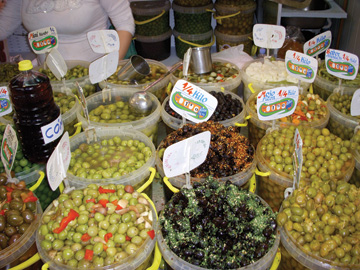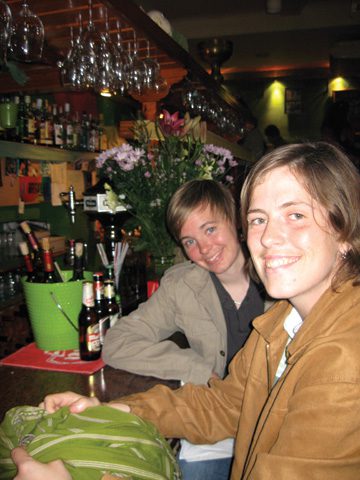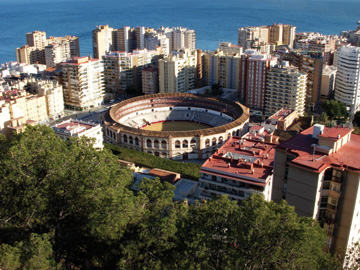Since 1978, when homosexuality was “legalized” in the Spanish constitution (a few years following Franco’s death), Spain has made an about-face in terms of tolerance. In 2005, Spain became the third country in the world to legalize gay marriage, and is now considered one of the more gay-friendly destinations in Europe. Gay tourism has increased accordingly; and while vacationers could easily spend an entire season bouncing between the myriad well-known Spanish destinations, Málaga beckons quietly, ideally situated on the southern central coast.
Part of the Costa del Sol region—which translates into “coast of sun” and 300 sunny days per year—over the last 3,000 years, Málaga has been transformed through a number of ruling empires from a quiet Mediterranean fishing town to the second largest port in Spain. Apart from local outdoor activities such as hiking, diving, boat trips, fishing excursions and huge expanses of gorgeous golf courses (there are no less than 70, playable year-round), you’ll find yourself soaking up more than sunshine and sea air. Málaga’s historic charm and richly woven culture, which includes Phoenician, Greek, Roman and Arab heritage, is evident in its architecture, endless monuments and gorgeous photo-op after photo-op.
Get Your Culture Fix First
There’s always time for tapas and wine, so plan out an itinerary that’ll take you straight to the ancient times. Near the top of your sightseeing checklist, you’ll want to include the Alcazaba (calle Alcazabilla, +34 9 52 22 72 30), a Muslim fortress built in the 700s, with a palace added on during an 11th century remodel. Tours of Moorish rulers’ and Arab officials’ living spaces take you through narrow hallways and cobblestone alleys. Up above and connected by foot paths or bus is the Castillo de Gibralfaro (andalucia.com/cities/malaga/ gibralfaro.htm), a newer Muslim castle (if you can call the 14th century “new”), overlooking the entire city.
Also not to be missed is the Cathedral of Málaga (Calle Molina Lario, 29015), an incomplete limestone building, started in the 16th century by Pedro Lopez and Diego Siloe. The lopsided building is nicknamed “La Manquita” or “The One Armed Lady” by locals after the planned-but-not-constructed second tower. Construction stopped and started many times over two centuries due to power struggles and lack of funds, so varying design and architectural styles can be spotted by the keen observer.
Just west of the cathedral, down tiny side streets in one of the oldest parts of the city, is the Central Mercado de Atarazanas, (Calle Atarazanas), which is a relatively humble name (“market hall”) in comparison to its striking high-arched marble entryway. Local merchants abound, their stands filled with flowers, fresh produce and seafood, and many other delicacies. If you’re more interested in Euro-fashions than in snacking, plan to spend some time walking down Calle Larios (at Plaza de la Constitución), the city’s number one shopping destination where you’ll find more designer and smaller regional labels than you would have thought possible.
You could say the city of Málaga is a work of art in itself, but it also happens to be the birthplace of one of the world’s favorite artists: Pablo Picasso. The room where Picasso was born is available for touring (Plaza de la Merced, 15), and happens to be situated right in the gayest part of the city, which you’ll no doubt return to after dark. A modest collection of his works is on display there, but there is a larger collection in the Palacio de Buenavista’s Picasso Museum (Calle San Augustin, 8).
With so much to see and do in so little time, it may make sense to schedule in a tour day. The private touring company Travels with Friends arranges local tours known as Private Shore Trips (privateshoretrips.com/malaga.html). There are five planned tours (or consult with them to create your own itinerary) starting at $675 per person, all offering transportation and a private guide, including Highlights of Málaga, Best of Málaga and Marbella (resort towns), Best of Granada (see below), Nerja Caves and Wine and Spanish Tapas.
Cool Your Heels
You’re undoubtedly still reeling from all that Málaga has to offer, but don’t forget that the region of Andalucia is renowned for its seaside golf courses and resorts. If you’re ready to settle in but not necessarily to settle down, one answer is to combine R&R with sport at the Hotel La Cala (Apdo de Correos 106, +34 952 669 016, lacala.com), on the property of Spain’s largest golf complex, located between the Sierra de Mijas Natural Park and the Mediterranean Sea, a half hour from the Málaga Airport. The hotel offers traditional Andalusian architectural style with all the modern amenities, and year-round packages that include green fees, treatments at Caracala Spa or mini schools at the property’s David Leadbetter Golf Academy. Special offers include a standard queen room with terrace, buffet breakfast and either one round of golf or one Thermal Circuit “Spa Experience” for $130 per person.
There are countless options for those who aren’t into the greener pastures of golf. Diva Espana (+34 699 519 554, divaespana.com), just an hour’s drive from the airport, is a serene women’s retreat that might just approach heaven from its perch in the Andalucian mountains. Run by two women, Diva Espana is a wonderful place to connect with like-minded travelers. Lounge around the pool and enjoy the breathtaking view or take a stroll through olive groves and along donkey trails. The nightly rate for en-suite room with breakfast is $83–89 for two women, $57–61 for one woman, and a self-catering apartment is available for $89-$96 a night. And, while you’re exploring the village of Comares be sure to be received by the friendly, gay hosts at El Molina de Los Abuelos (952 509 309, Balcón de la Axarquía, #2), a restaurant sure to fuel your adventures there. Just be sure to place reservations in advance if you’re hoping to try their famous lamb dishes, as there is a limited quantity of lamb per day.
If you’d prefer something closer to the gay district, get comfy back in central Málaga at Molina Lario (from $122, Molina Lario 20-22, hotelmolinalario.com), a four-star hotel with 103 rooms, within walking distance to all the city’s hotspots. Also in the neighborhood is El Riad Andaluz (from $106, Calle Hinestrosa 24, www.elriadandaluz.com—editor’s note: www must preface the URL), a cozy eight-room, two-star guesthouse run in the Andalusí tradition, located on a quiet street in the oldest part of the city. Picasso’s Corner Backpacker’s Hostel (from $32, San Juan de Letrán 9, picassoscorner.com) offers private rooms with a shared bathroom and a common area where tired travelers often sit to smoke a shisha (hookah) and share the stories of the day. Despite its humble name, the establishment boasts two rooftop terraces with hammocks, a big-screen satellite TV, free Wi-Fi, a bar, a fully outfitted kitchen and “disco showers” complete with glowing lights, music and multi-directional water.
Eating & Drinking Like a Local
The regional specialty is…you guessed it: fresh seafood. You won’t want to miss the variety of ways the locals prepare it, whether it’s just-caught fried fish from a street-vendor, or an aromatic bowl-full of traditionally prepared clams in ajoblanco or gazpachuelo Andaluz in any one of the restaurants all over the city. It’s hard to go wrong, but if you need a little direction, try Mesón Astorga (calle Gerona, 11, +34 952 342 563) for regional fare and desserts; the vegetarian menu at El Legado Celestial (calle Peregrino, 2, +34 952 351 521); Al-Yamal’s Arabian cuisine (Blasco de Garay, 7, +34 952 212 046; and for traditional Castilian cooking and an extensive wine cellar, Maese Pérez (calle Pelayo, 4, +34 952 303 124). And remember, you absolutely must try fresh anchovies in Málaga!
Andalusians love to celebrate and honor tradition, and almost any time of year they’re gearing up for one festival or another. One of the most famous is the Málaga Feria (andalucia.com/festival/malaga-feria.htm) in August. Travelers from all over flock to the city for a week of live music, singing and flamenco performances all day and festivals and celebrations that don’t stop until dawn.
Year-round reveling is always underway in Málaga’s gay district on Plaza de la Merced, a square representing the cradle of liberties with a central obelisk memorializing General Torrijos, who was executed on La Térmica beach for defending civil rights. So take a moment to appreciate this significant monument before exercising your civil liberties at the surrounding queer bars. Start with Sobrelasmesaslastazas (translation: “drinksareonthetables”) and duck in to El Telón, Calle de Bruselas, El Convento and Flor de Lys on the way to Bombay (Plaza de la Merced 1, 8, 14, 18, 21 and 290 respectively). If you want to keep up with the locals, start the night out with a free tapa for every cocktail and expect to party until dawn.
To get your Euro-groove on, consider taking a 15-minute drive to Torremolinos, Málaga’s neighboring town with its own sizzling gay nightlife. Club Passion (Palma de Mallorca 18) has been a destination discothèque for gays and lesbians in the Costa del Sol region for over ten years. Don’t show up before 1am, when the modern, multi-leveled dance floors start to fill with projections of rainbow colored lights, pumping Euro-beats and a diverse mix of gyrating, sweaty bodies.
Day Tripping It in Granada
Granada is an hour due North of the coast in the foothills of the Spanish Sierra Nevada mountains, and is the hometown and current home of gay artist extraordinaire Federico García Lorca, a fact which the city never forgets to celebrate. Granada is also home to the flamenco, and dancers can often be found patrolling the streets as they hand out flyers to private shows for only $20 per person.
Granada is accessible by train, but only via an out of the way transfer in Bobadilla (raileurope.com). The easiest way to visit is to rent a car, or arrange a private half- or full-day tour as mentioned above. Car rentals are available from the airport, and start at $175 per day; GPS and cell phone rentals and chauffeured limousines are also available (888-223-5555, autoeurope.com).
Granada is filled with international students, and tends to have a more liberal (and more queer) atmosphere. The Alhambra Palace (alhambradegranada.org) is a major draw for visitors from all over the world, and was nominated to be one of the New Seven Wonders of the World in 2007. The Alhambra is not only a fortress and a palace, but is considered to be a world-renowned work of Islamic art. To get to the Alhambra, an early morning walk up a very steep hill is required (or go against tradition and take the bus). There is limited entry inside the palace, and tickets sell out early, so you’ll want to get in line by 7am. (And don’t even think about being late for your given entry time!) The gardens, reflection pools and fort surrounding the palace are available to tour anytime you like; there are no entry limits or time constraints.
In Granada, the tradition of eating and drinking is taken very seriously and the most substantial meal of the day is lunch. In typical siesta style, businesses close for three hours in the afternoon to give locals a chance to dine, nap and get back to work. Tapas are the rule for evening-time, and you’ll usually get a free tapa with every drink. In addition to wine or beer, alcohol-free beer or grape juice are popular, or a local favorite, tinto de verano, which is red wine with soda (Coke or Fanta) over ice—sort of like sangria (well, not really).
Tapas joints are everywhere, and some areas of Granada specialize in certain types and styles. For example, El Meditárraneo (Calle Gracia at Verónica de la Magadelena) offers Greek- and Turkish-style tapas, while the “marcha zone” (near Pedro Alarcon) caters to the young hipster crowd. Casa Julio (Calle Hermosa, Plaza Nueva) is a traditional tapas bar in the city center, and is well worth the wait and elbow-rubbing.
If you’re ready to drink with the local rainbow set, there are a number of venues from which to choose. La Sal (Santa Paula 11) is the longest standing gay bar in Granada, and started out as a lesbian bar, though today draws more of a mixed crowd. La Tortuga (a.k.a. The Turtle, marked by rainbow flags on the corner of Calle Elvira and Calle Aguirre) also draws a diverse crowd of lesbians, gay boys and straight couples. It’s usually packed early (meaning around 10pm), and stays packed until the wee hours. For a little spice, check out 6 Colours (Tendillas de Santa Paula 6, sixcolours.com), a late-night gay and lesbian bar with a dance floor, or see a weekend drag show at the dance bar Fondo Reservado (Cuesta de Santa Inés 4).
If you decide to stay the night, and actually want to get some sleep, private, modern apartments are available in central and historic areas of Granada (from $96, granadainfo.com), and the Oasis Backpacker’s Hostel ($51, Placenta Correos Viejo, 3, oasisgranada.com) has double rooms, and offers a less expensive dorm-style option.






What Do You Think?